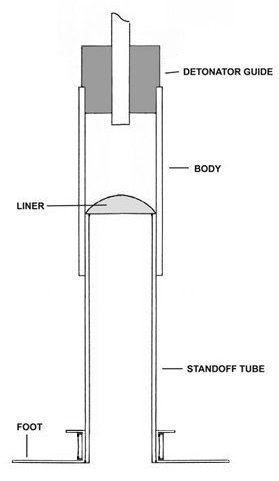Black Adder disrupters are designed to be easy to make and use, so providing a way in which Explosively Formed Projectiles (EFP) can be easily made and used to disrupt munitions and explosive hazards. Despite popular opinion, the projectile formed by an EFP is not 'plasma'. It is not even hot enough to make copper melt. It is under such immense pressure that a solid liner acts as a liquid and the target material also acts as if it were fluid. The target is not melted or burned, it just flows out of the way.

An EFP can be either a 'jet' or a 'slug' depending on the shape of the 'liner' that will make the EFP. A jet gives maximum penetration so is usually used in armour piercing munitions. A slug does not penetrate as far but makes a larger hole in the target and is less inclined to pass through both sides of a small target.
The Black Adder differs from other designs of disrupter by using a relatively thick 'liner' to deliver materials which encourage the slug to dissipate and burn inside the target. Those materials are readily available and the entire disrupter can be easily made at low cost in the country of use. While a deflagration or detonation is less likely that when using many other designs of liner, there is always a risk that the target will detonate when using any disrupter.
EFP disrupters often fail to form a jet or slug when air is entrapped inside the high explosive used behind the liner. To avoid this, the Black Adder has a clear acrylic body that allows air to be seen when filling it. EFP disrupters may also fail to penetrate the target when the standoff distance is too short for the penetrator to form, or when it is so great that the penetrator has started to break up before it hits the target. To avoid this, the Black Adder is designed to be used with an optimal stand-off distance.
The liners are made using a carjack press, copper sheet and unrestricted chemicals to give oxygen and fuel to assist with the burn.
The early testing of the Black Adders was reported in the JMU Journal of Conventional Weapons Destruction (November 2017) and can be read here. The PDF includes many pictures which explain its use. The picture below shows its effects on fuzed mortar bombs, having burned the high explosive and generated enough gas pressure to blow the fuze from the munitions.